Note: If an image ever fails to appear - refresh your page, it really is there
Flags of the State of Utah
Studying the historic flags of Utah is very complicated because of the similar and related designs, and the fact that the flag documentation is at times sparse, incomplete, and can lead to multiple interpretations. For example, from the arrival of the Mormon Pioneers in 1847 through the Provisional State of Deseret and Utah Territory period many variations of the stars and stripes were displayed. These flags were unique and sometimes only one existed. Many had red and white stripes; some blue and white stripes, and some even had red, white, and blue stripes. The unions were usually blue with white stars, but occasionally white with blue stars or even white with red stars. Unfortunately for the flag scholar, exact colors were only mentioned in a few instances. They were usually described vaguely as the stars and stripes, the national flag, or the Deseret flag. No single flag was a standard pattern.
Here's another example. At Brigham Young's death in 1877, Don Maguire, a non-Mormon mining equipment peddler from Ogden visited Salt Lake on the day of the funeral. He saw and described a flag displayed from the second story of a home of Heber C. Kimball, one of Young's late associates. He described it as a stars and stripes with blue and white stripes. He didn't say how many stripes. He described a blue canton with a circle of 12 white stars surrounding a larger central 13th star. He did not describe how many stripes deep the canton was or how many points the stars displayed.
Maguire went on to assert that this flag was "the flag of Mormon supremacy" which Young had raised on Ensign Peak in 1847. When the flag was removed from display about 2 pm, Maguire further suggested it was folded and placed with Young's body before burial. Although, Maguire can be trusted on his description of the flag, his comments about the flag's significance and its history are doubtful.
The Mormon Church (a nickname) is properly called the Church of Jesus Christ of Latter-day Saints in the first reference, and may then be called the "L.D.S. Church" or "Mormon Church" thereafter. Members of the Church of Jesus Christ of Latter-day Saints are commonly called Mormons or Latter-day Saints. Descriptive terms such as the Mormon Train and Mormon Pioneers are historical and appropriate when used in that context.
Here then, are some of what we know about of some of the historical flags of Utah.

26-Star Flag 1822-1836
|
First Recorded Display of the Stars and Stripes in Utah
In the spring of 1825, American Fur Company trappers rode into the rival camp of Hudson's Bay Company on the Weber River near Mountain Green, Utah. The Americans carried the American flag into the camp of Peter Skene Ogden and his men declaring the area to be US Territory. In fact, both groups had wandered from Oregon Territory into land belonging to Mexico. Offered a better price for their pelts, many of Ogden's men joined with the Americans, and the site became known as Deserters' Point. We don't know exactly what US flag was displayed or if Ogden flew the flag of Hudson's Bay Company. However, the Official US flag in 1825 had twenty-six stars.
|
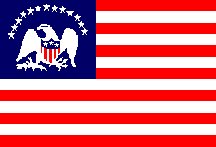
Presentation Standard 1804
|
Indian Department Eagle Presentation Flags 1803-c1862
If an Indian tribe showed willingness to come under the "protection" of the United States they would sometimes be presented with a special version of the United States flag by the Indian Department. These presentation flags usually had eagles and thirteen stars in their cantons.
This practice began with the Lewis and Clark expedition when they presented one such flag to the chief of the Mandan Indians and another to the chief of the Teton Indians in 1804. Andrew Jackson presented another presentation flag to the Chippewa Chief Sheeboy-way in 1809. This practice continued throughout the early 19th Century.
There is no record of the War Department Indian Presentation Flags being given to Utah's Indians, however, it was a typical practice. Utah's tribes spilled over into surrounding states and tribe members residing in or out of Utah's present boundaries may have received such a flag, but the historical record is silent if that did in fact occur. |
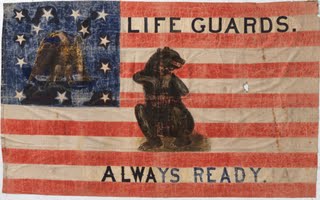
Mormon Battalion Flag
|
Mormon Battalion/Nauvoo Legion "Life Guards" Flag
The Mormon Battalion Flag might be one of the oldest "California" Bear flags in existence. Tradition says this flag was carried by the Mormon Battalion when it was in California in 1846-47, and in fact, the Bear was added to the flag while the Mormon troops were in California under the command of Lt. Col. Philip St. George Cooke. The march of the Battalion, first from Council Bluffs (Iowa Territory), then to Santa Fe (New Mexico), and finally from New Mexico to California is one of the longest American military marches in history (over 2,000 miles).
Whether the existing flag is the original still needs to be determined, but if examination proves it is genuine, it could date as far back as the 1840's and Nauvoo, Illinois, or perhaps even earlier to Mormon settlements in Missouri. The extant flag was used by the Nauvoo Legion (the Utah Territorial Militia named in honor of an earlier military organization in Illinois) without doubt. The existing flag, however, might also be a replica of an earlier flag. The flag is in the possession of Eldred G. Smith, Patriarch Emeritus of the L.D.S. Church. The Smith family tradition dates it back to the Mormon Battalion and numerous journal, books, and newspaper quotes over many years also tend to support their family tradition.
Some even believe that this is the nine-foot-long Battalion flag raised by the Mormon Battalion at Camp Moore, Los Angeles, California on July 4, 1847. It is more probable that a regular U.S. flag either carried to California by the U.S. Army or U.S. Navy was used.
|
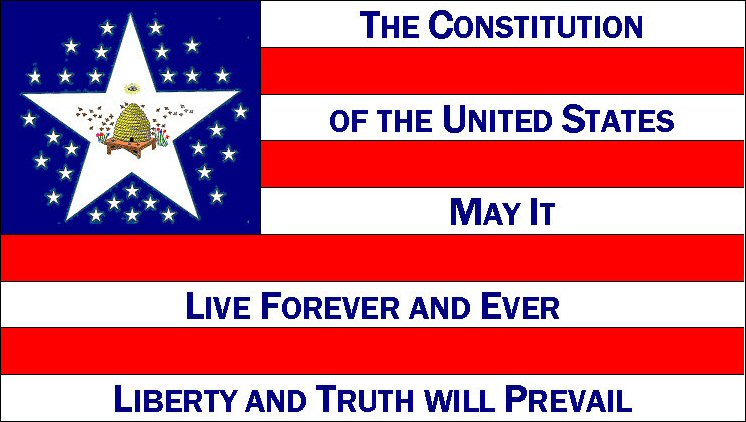
Kanesville Banner 1849
(reconstructed drawing)
|
Kanesville, Nebraska "Deseret" Banner 1849
The Pioneer Settlement of Kanesville or Winter Quarters, located in an area now part of present day Iowa, was a way station on the Mormon Trail where Mormon Pioneers spent winter months and grew crops for resupply emigrants on their way to the Salt Lake Valley.
On Saturday, September 8, 1849, the inhabitants of Kanesville, Iowa celebrated having receiving news of the good harvest in the Salt Lake Valley. "Also was manifest their gratification in regard to the to the formation of a State Government at Salt Lake; and the new State of 'Deseret' was welcomed with smiling faces and gladdening hearts." Robert Campbell designed and painted a "magnificent" banner described as a Stars and Stripes design. This illustration is a reconstruction based on a somewhat vague written description. The flag was decorated with blue tassels which are not shown. The flag would likely not have been as precisely drawn as shown here.
It was reported in the Frontier Guardian (September 19, 1849) thus: "The banner for the occasion was designed and painted by Robert Campbell of this town, which was magnificent. The design was the Stars and Stripes. In the centre was a rising star represented, and in the centre of that was a bee-hive with flowers for relief, in the two sides points were where the bees all busily engaged, an on the upper pint was an eye, made to represent the all-seeing eye of Jehovah. The whole decorated with an excellent display of blue tassels. In the white stripes of the flag was the words, 'The Constitution of the United States, may it live forever and ever,' 'Liberty and Truth will prevail.' This was carried a the head of the procession; next in order was our splendid band of martial music, under the direction of Mr. Pitt, which done great honor to the occasion."
|
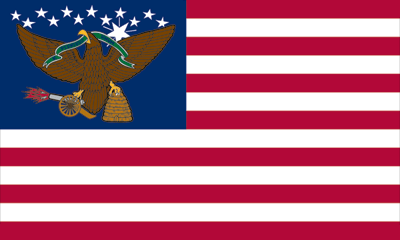 The Deseret Flag #1 (reconstructed variant)
Since there are no contemporary pictures of the flag, it must be reconstructed from accounts in newspapers. We are always quick to interpret descriptions to fit the usual pattern of the US flag. Shown here are several such possible variations. Obviously, the proportions are wrong, and they are speculative in nature, since the newspaper stories did not even specify the colors.
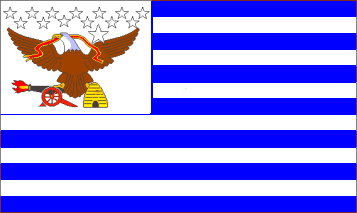 The Deseret Flag #2 Using white canton and blue and white stripes (reconstructed variant) |
The Deseret National Flag 1851
The Utah territory was settled by the Mormons. After the Mexican-American War in 1849, the Mormon Settlers petitioned Congress for the admission of the State of Deseret. Instead, Congress created the Territory of Utah. Subsequent petitions were rejected over the next decades due to the lack of separation between church and state within the territory and the Mormon practice of polygamy. In 1896, the State of Utah was finally admitted to the Union.
 This reconstructed drawing of the Desert National Flag made by John Hartvigsen, This reconstructed drawing of the Desert National Flag made by John Hartvigsen,
although shortened a bit here to fit this frame, is the most accurate proportion-wise illustration we have.This gigantic Deseret Flag was hung from a pole next to one of several early meeting buildings known as the Bowery. Salt Lake's Temple Square and the Temple with its famous six spires wasn't dedicated until 1893, and the domed-shaped meeting hall known as the Tabernacle was yet to be completed. The Bowery was used both for religious meetings and public events.
The huge flag, made just after the Mexican-American War in 1851, was 14 ½ feet tall by 45 feet long, with the union canton measuring 10 feet by 10 feet square. The newspaper accounts do not say how many stripes it had, but there are existing flags of the period with nine stripes, some had red and white stripes, some blue and white stripes, or even red, white and blue stripes.
The flag featured an eagle in the canton holding a firing field piece (cannon) in its left claw, and a beehive in its right claw. The beehive was a common symbol used by the Mormons ever since they settled the territory in 1847. The eagle holds an E Pluribus Unum scroll in its beak, and 14 stars are spread across the heavens above its head. |
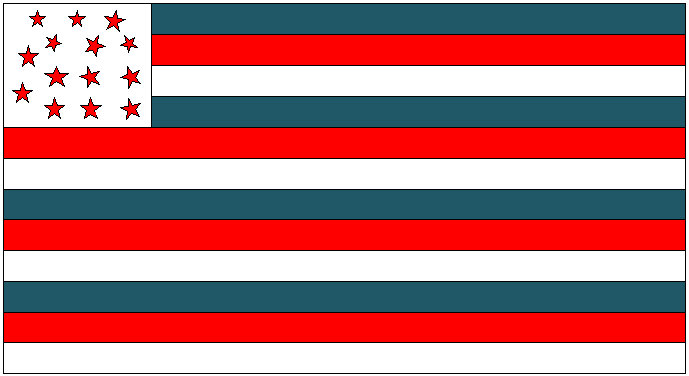
Williams Flag c1850
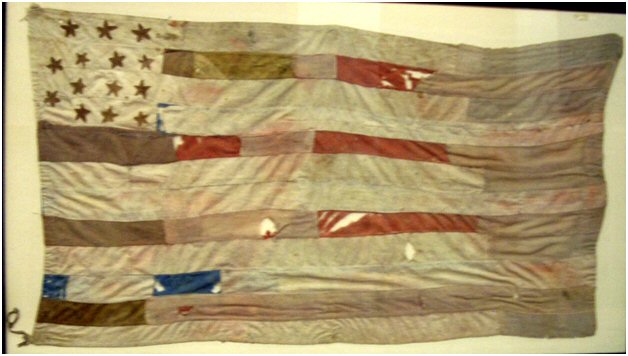
Williams Flag (actual)
|
Edward H. Williams Flag c1850-1851
Made between late 1850 and early 1851, this flag was constructed like a patchwork quilt. Edward H. Williams, a tailor, and Eliza Benson, a milliner, left Great Salt Lake City in December of 1850 as part of the George A. Smith party traveling to settle near what is now Parowan, Utah. Williams and Benson gathered scraps of cloth form members of the party to make a flag. They died the cloth using vegetable dies and sewed the pieces together in the evenings to produce a red, white and blue Stars and Stripes flag measuring about twenty-one by forty-four inches.
When Williams moved north to Salt Creek, near present day Nephi, he took the flag with him. There it was used by the local militia and in parades during the last half of the 19th Century.
Around 1950 it was borrowed for display and washed as it was thought dusty and dirty. Much of the color washed out or migrated to the fly end of the flag when it was hung by the hoist to dry. It has since been mounted in a frame and is on display in the Daughters of the Utah Pioneers' Museum in Nephi, Utah.
The colors shown in the illustration were determined in consultation with a fabric curator.
|
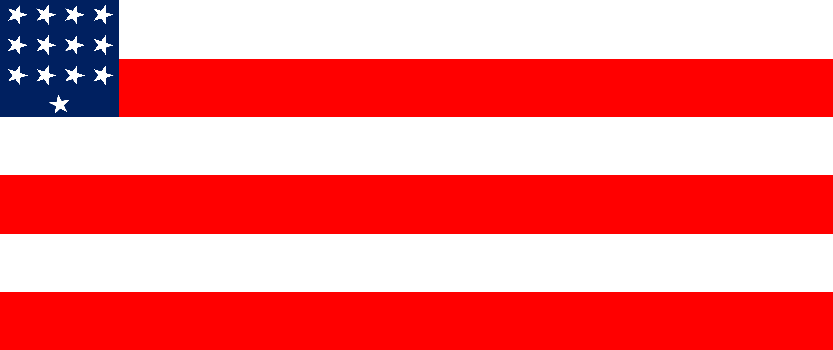
George A. Smith Parowan Flag
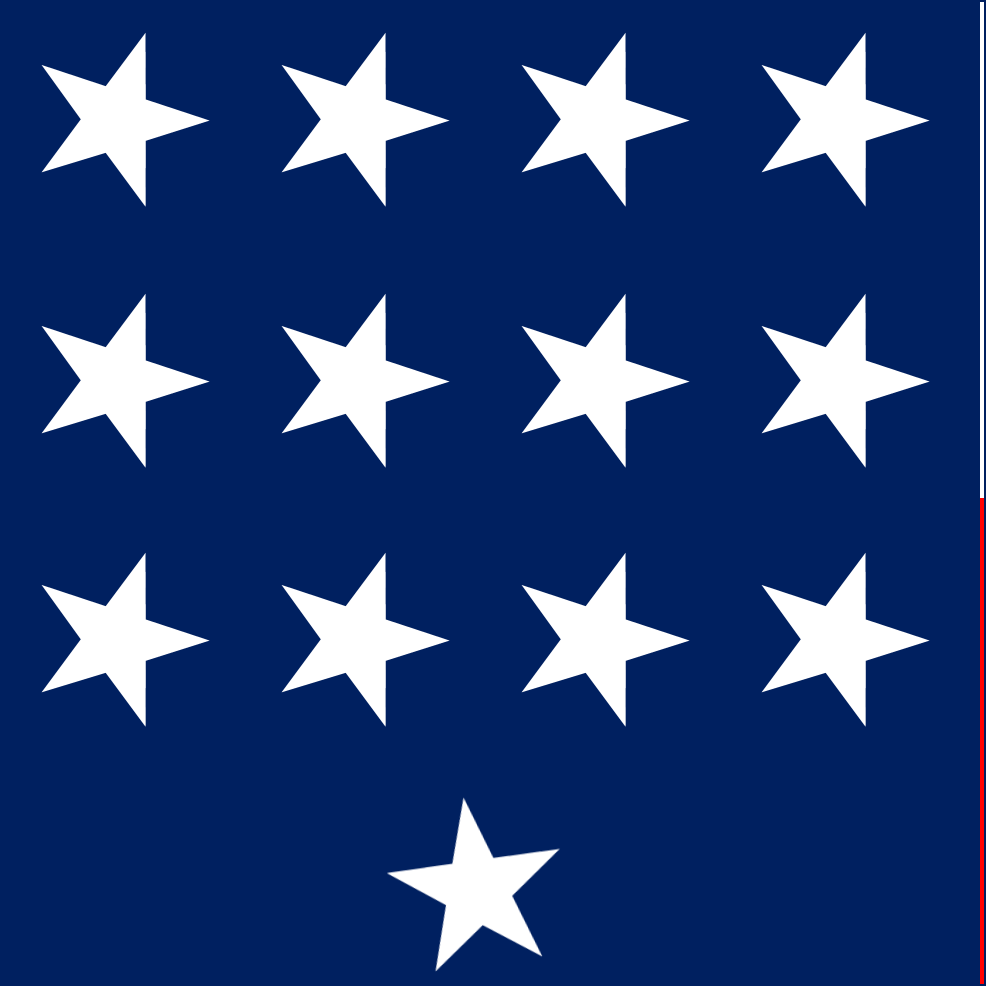
Canton Detail
|
The George A. Smith Parowan Flag 1851
During the winter of 1850-1851, a band of Mormon pioneers left Great Salt Lake City to found the "Iron Mission" near what is now Parowan, Utah. This handmade flag, preserved by the descendants of George A. Smith, the leader of the group, was according to family tradition raised at Heap Hills on January 15, 1851, from a Liberty Pole erected a year earlier by Parley P. Pratt and his group of explorers. Pratt and his group also raised an unknown free soil banner, reportedly bearing a single star, whose actual appearance is unclear.
The flag is now in the possession of the History and Art Museum of the Church of Jesus Christ of Latter-day Saints. An interesting feature is the slant on the stars, all match with a rotation to the left, except the lone star on the bottom row.
The meaning of the differently positioned star might have been meant to represent Utah's star, or the Rising Star of Deseret, or may have been simply the result of artistic license by the maker.
|
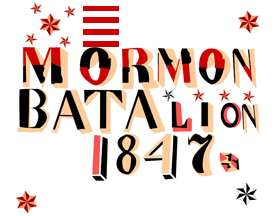
Mormon Battalion Flag
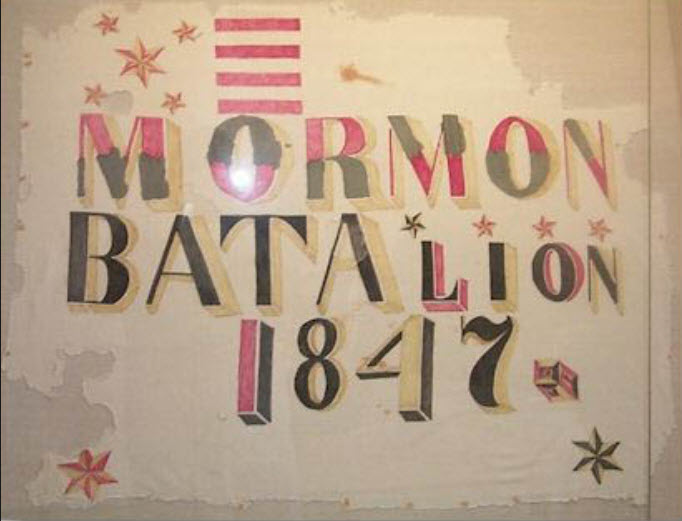
Mormon Battalion Flag
(actual flag)
|
Mormon Battalion Veterans´ Flag c1855
In 1846, the Mormon Battalion was formed at Council Bluffs in the Iowa Territory, under the authority of US Army of the West, from a large makeshift encampment of Mormon refugees. More than 500 men, 32 women, and more than 50 children from the Church of Jesus Christ of Latter-day Saints volunteered to serve in the US Army. They were enlisted to join forces with General Stephen W. Kearny and fight for the United States in the Mexican-American War.
They were destined to play an important part in the early development of California. They later made bricks that were used in constructing houses throughout southern California, and built Fort Moore in Los Angeles and the Courthouse in San Diego. Many eventually settled in California after the war.
This flag is believed by some to have accompanied the Mormon Battalion on it famous march. However, the date of 1847 shown on the flag is indication that it was made after the march. As with 1776, the year 1847 only gained symbolic meaning in the years that followed. The flag is one sided is not constructed well enough to have been carried on the march. In parades held in later years, veterans of the famous infantry march carried flags and banners like this one in patriotic parades. Even if it is a veterans' flag and not the flag of the Battalion used during the march, it is significant in that the design in the canton is likely patterned after a flag of Deseret in use when the flag was made. The drawn image supposes an additional red star in the upper right corner, which may not have existed or have been of different design. |

Kimball/Maguire Flag 1877
(reconstructed variant)
|
Kimball/Maguire Flag 1877
There was no standard flag used to represent the Deseret Territory (1847-1896) colonized by the Mormon pioneers in the mid-1800s. Many of the flags had red/white/blue or just blue/white horizontal stripes, sometimes with stars of white in the canton.
This reconstructed flag of the Kimball/Maguire Flag is based on a description made by an early territorial trader named Don Maguire who claimed he saw it displayed from a second story window of the home of Heber C. Kimball. Maguire was a non-Mormon who traveled to Salt Lake when Brigham Young died to make sure "the old devil was dead." It was he that made the highly speculative assertion that the flag had first been displayed on Ensign Peak, but the records do not support his claim.
For more information about this flag see The Ensign Peak Flag.
|
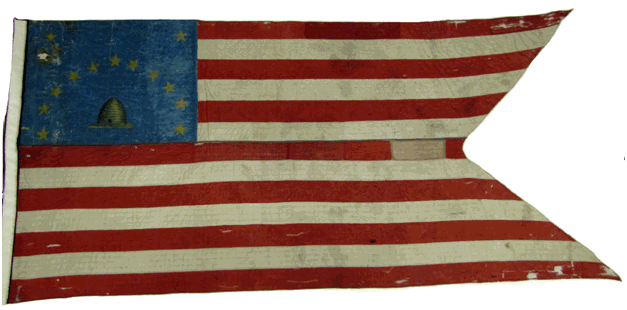
Probable Nauvoo Legion
Cavalry Guidon
|
The Mysterious Beehive Flag with the Swallowtail
Unfortunately, we know little about this unusual flag´s history or provenance. Originally in the collection of the Deseret Museum, it was loaned by the L.D.S. Church for display in the old Salt Lake City Council House, which sits across from the Utah State Capitol. The flag's origins are still unknown, however, it probably dates back to territorial days.
Deteriorating badly, the flag was almost lost when it was given by Council Hall staff members to John Cross, a former now deceased NAVA member. Cross stabilized the flag at his own cost and returned it to the L.D.S. Church where it is now preserved in the LDS Art and History Museum's collection. In short, we know it exists and therefore it must have a story.
|
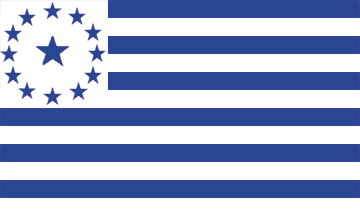
Purported LDS "Church" Flag
|
Mormon Flag of God´s Kingdom (purported)
This blue and white "Deseret Flag" is not a historic flag of Utah, but a 20th Century variant modeled after the earlier 19th Century flags. The designer of the flag promoted it as the "Mormon Flag of God´s Kingdom," or more simply the "LDS Flag," However, although the promoter suggests that it is a church sponsored flag, it is not an official symbol for the Church of Jesus Christ of Latter-day Saints, nor is it in anyway, a church sponsored flag.
The unfortunate display of this flag as one of three permanently flown on the three flag poles at the base of Ensign Peak has given it an unwarranted impression that the flag has a historical tie to Ensign Peak were none actually exist. A dome shaped outcropping of rocks that rises 1,080 feet above the valley floor, Ensign Peak is situated at the head of Main Street (see picture of park entrance) and dominates the sky line above the Utah State Capitol, Pioneers climbed this mount two days after their arrival to get a better view of the Salt Lake Valley. Pronouncing it a "good place to raise an ensign," they named it Ensign Peak. They carried no flag with them on that day, and most certainly the "Mormon Flag of God's Kingdom" has no historic link or association with Ensign Peak. |
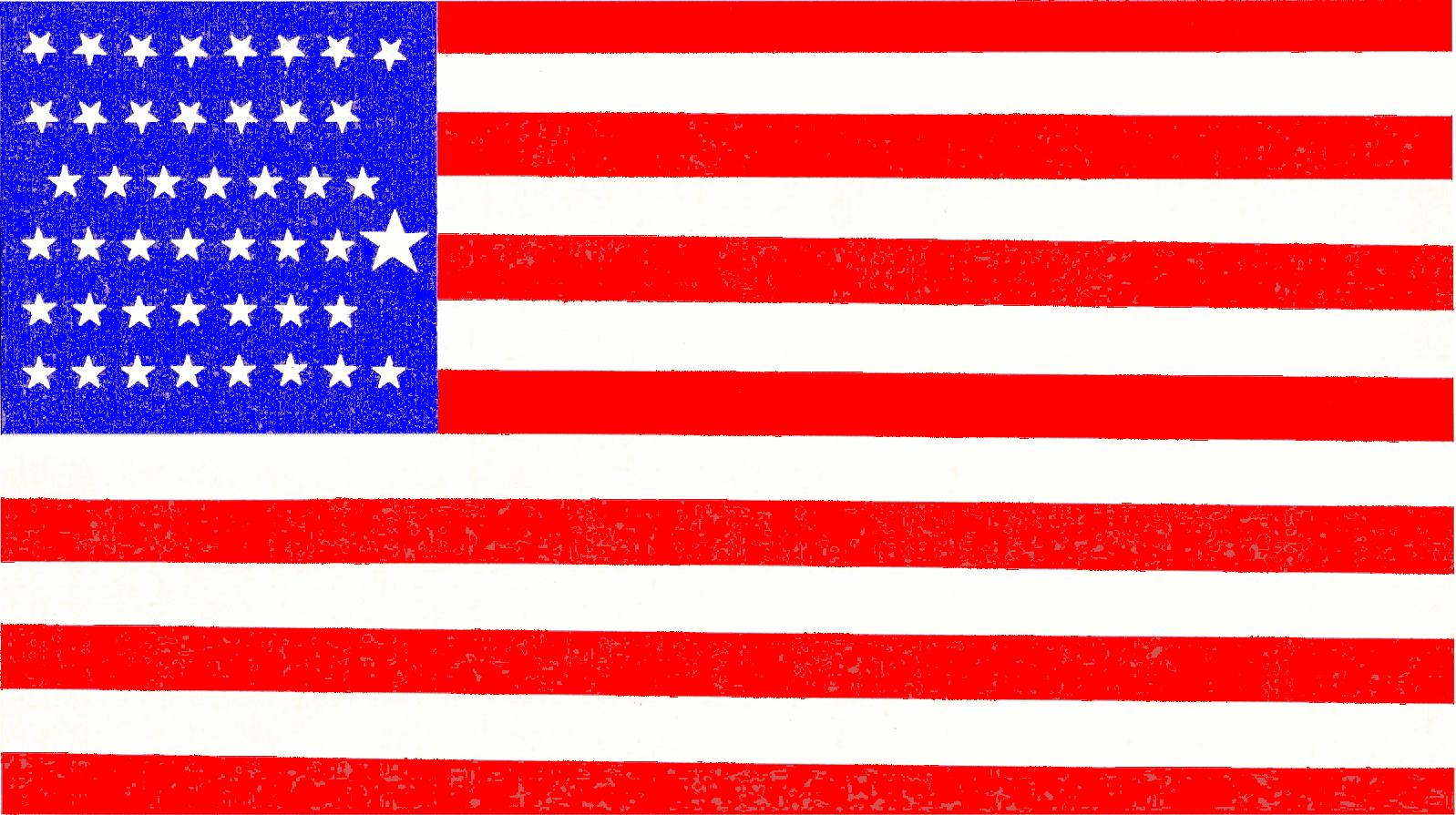
45-Star US Flag
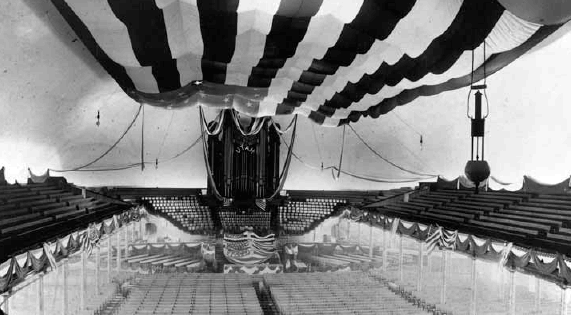
Tabernacle January 1896
(with flag being moved into place)
|
Gigantic United States Flag c1896
On January 4, 1896, Utah became the 45th State to join the Union. Naturally, there was a rush to design a new national flag to display 45 stars, and in Utah they made one 74 feet high by 132 foot long, which was then the largest flag in the world, to celebrate the end of their long struggle to become a state. They added a huge enlarged star for Utah. The gigantic 45 star flag was displayed at the inaugural ceremony for Utah's statehood suspended from the ceiling of the Tabernacle. The entire community took part in those proceedings. The Tabernacle was then the largest meeting space in the Utah. The canton of the huge flag covered the dome of the Tabernacle, and had the new star symbolizing the Rising Star of Deseret displayed with an electric light inserted behind it, so that it shone throughout the Inaugural Ceremonies.
The large flag was moved to the outside south wall of the Salt Lake Temple in July of 1897 to celebrate the fiftieth anniversary of the Mormon Pioneers arrival in the Salt Lake Valley. It was displayed there each succeeding July until it became torn and unserviceable in about 1903 and was destroyed.
One must remember that the star pattern used in the canton of the United States flag was open to interpretation, and there have been a variety of un-official designs used over the years, such as this one, but few as large.
(More variant star patterns can be seen on the "Many Constellations of Old Glory" page.)
|

Utah First State Flag 1903
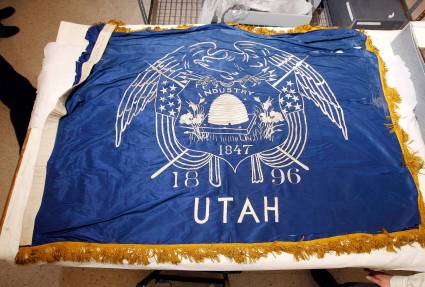
Rediscovered First State Flag
(with word "UTAH" added)
|
St. Louis World's Fair Flag 1903
Utah's first unofficial state flag was embroidered in 1903 at the request of Governor Heber Wells. He requested help on the project from the Utah State Society of the Daughters of the Revolution explaining he needed a state flag to be display at the St. Louis World's Fair. It was Agnes Frenelius who was chosen for the project, which she completed in March of 1903. The original flag was misplaced for years and all that remained was one black and white photograph, but recently it was re-discovered and shown here in the second picture.
This early flag would help determine the basic design of all future Utah State flags. The word "Utah" embroidered to the bottom of the flag sometime after 1905, and it was used unofficially as the State flag by the governor for years before it was misplaced.
The Utah flags made in the first years were all made for parades and indoor display, and thus a fringe was appropriate. However, fringed flags have never been required by the state, although the fringe is mentioned in the law. A fringe would be inappropriate for outdoor flags raised on flag poles, and had never been used or required.
For more information about this flag and other variants see Early Versions of the Utah State Flags.
|

Utah State Shield 1903
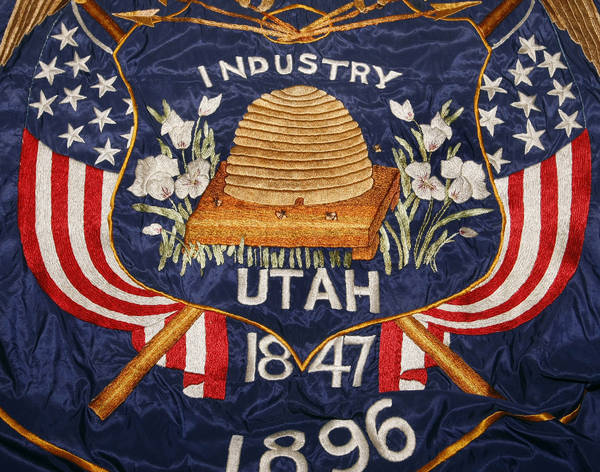
Incorrect State Shield 1922
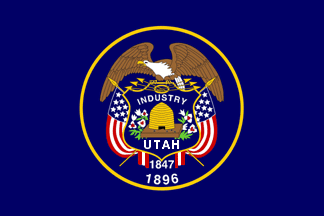
Incorrect Variant 1922-2011
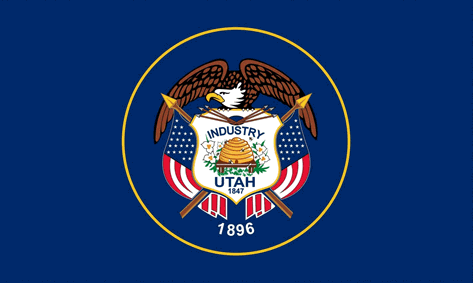
Restored Utah Flag 2011
Prototype Version
|
The Crusade to Rediscover the Design of the Utah State Flag
Utah's official flag was adopted in 1913. The flag has a deep blue field with the state seal in the center, surrounded by yellow fringe. The state seal upon which the Utah State flag’s design is based was designed by Harry Emmett Edwards in 1896. A non-Mormon, Edwards was a local artist, bank-teller and sometimes bar tender. He left Utah for the gold fields of the Klondike, and never returned to the Beehive State.
The Utah State flag displayed this unnoticed error of the State Shield until vexillologist John M. Hartvigsen spotted the mistake in the 1980s. This error had gone unnoticed for about sixty, when Hartvigsen first spotted the discrepancy while examining the flag's legal description contained in the state codes. Basically, what he noticed was that the numerals for the year "1847," honoring the arrival of the Mormon pioneers, had been moved from their original position on the shield at the flag's center to a spot just below the shield.
Thus began one most interesting crusades in Utah flag history. The acceptance of this flag gives us a classic example of a "suppositious" flag; an error repeated so often it becomes accepted as fact. For more than eighty years in all, from about 1922 until 2011, Utah flag manufacturers had reproduced the mistake until it had been become standard, so Hartvigsen wondered, how to we undo the mistake after all this time, and was it really that important? He decided it was.
Although the actual correction to be made was a small one, simply return the numerals for the year 1847 to their correct position immediately below the word Utah and the Beehive, getting the legislature to recognize the problem and then ordering the change wasn't an easy chore. However, Hartvigsen now felt that in respect to Utah history, the Utah State flag it should be described, illustrated and manufactured correctly.
After discovering the problem in the 1980s, he began sharing the information with any state official, historian, reporter, and anyone else who would listen. In 2010 Hartvigsen and Ron Fox collaborated in a search to locate the original 1903 Utah State flag which had been lost. At Fox's insistence the staff at the Utah State Historical Society made a new search and found the missing flag in an unmarked box they had received from the state archives. Hartvigsen shared the story of the error in the Utah State flag with Fox. The two resolved to have the error fixed.
Finally, State Representative Julie Fisher heard and believed. She sponsored a Resolution in 2011 that was passed admonishing flag manufacturers to make the Utah State flag in accordance with existing State law and the flag's history. In 2011, the State Shield on the flag was officially returned to its original design and colors, and the flag and its symbols once again appeared as they were when first designed.
For more information about these flags and other variants see Early Versions of the Utah State Flags. |
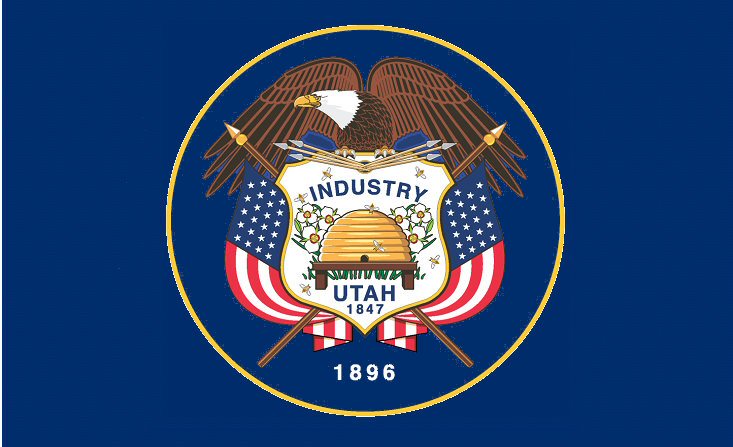
Restored Utah Flag also 2011
Enhanced Version
(with modified eagle and shield)
|
Utah State Flag 2011 (enhanced variant)
An artist at the Colonial Flag Company, produced the artwork for the corrected Utah State flag used during the Legislative process. The flag was drawn following the legal description and using the colors of the flag made for presentation to the USS Utah in 1912. Although colors were not included in the law describing the Utah State Flag as adopted in 1912 and amended in 1913, they were described in other state documents. Utah officials asked that those colors be used. However, they declined to include an illustration with the House Concurrent Resolution, saying that was not possible.
As with many flags with seals and coats of arms, there is room for artistic interpretation while still following correct designs. Paul Swenson, who as the President of Colonial Flag Company had paid for the prototype design, felt the eagle as shown in that design was weak and unattractive. He had graphic artist Perry Van Schelt strengthen the design while following the same description and using the same colors as employed in the prototype. Both the prototype and the enhance designs are correct and follow the law and intent of the 2011 legislation. Only a few hundred flags were ordered using the prototype design, and most flags now being made and sold use the enhanced design, but legally flag manufacturers are free to use either version. |
- My thanks to John Hartvigsen for his invaluable help and input on this page -
| Top of This Page | Flags of the United States | Home Page |
|